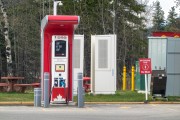“Transportation is the new electricity.”
That was the line I heard over and over in California a few weeks ago, where I was lucky to attend the Global Climate Action Summit.
In a seriously good news climate story, the State of California has met its 2020 carbon pollution reduction target two years early. Much of California’s success to date has been in cleaning up its electricity grid, and this is why transportation – which contributes 41% of California’s emissions – must be tackled next.
This situation isn’t limited to California: transportation is a leading polluter in many jurisdictions. In Canada, our transportation sector alone pollutes more than what our entire economy can pollute in 2050 if we’re to do our part to mitigate climate change and decarbonize by mid-century. In light of the IPCC report release this week, it’s clear that effective solutions and strong political action on climate are more urgent than ever.
Despite that reality, carbon pollution from transportation just keeps growing. Why haven’t we been able to stop this trend? One reason is that transportation choices are made by millions of individuals and companies on a daily basis – so coordinated action is difficult. Further, we keep building our communities in ways that lock us in to carbon-intensive patterns of people and goods movement (e.g. urban sprawl, unsafe routes for biking and walking, etc.).
But times are changing, as was made clear at the Summit in California. Clean transportation technology is ready for deployment and costs are plummeting. This, along with public frustration about air pollution and a desire to grow clean jobs, is driving the adoption of smart transportation policy across the world.
Global momentum
Take, for example, the Transport Decarbonization Alliance, which unites leading cities, countries and companies to transform the global transport sector to a net-zero emission mobility system before 2050. At the Summit, I had the pleasure of witnessing California and Deutche Post DHL join 16 other members of this coalition. Closer to home, Quebec and British Columbia are members of the ZEV Alliance, which seeks to expand the global zero-emission vehicle (ZEV) market and enhance government cooperation on ZEV policies.
An important trend to watch is the increasingly long list of cities, states and countries who have set deadlines to end the sales of fossil fuel-powered cars. As we’ve noted before, these announcements are important because they give industry and consumers greater certainty about market trends to guide their investment decisions. These jurisdictions back up their commitments with policy and programs to support the transition.
While the shift to zero-emissions heavy-duty vehicles is less advanced than for passenger vehicles, this is also changing quickly: nearly 90,000 electric transit buses were sold last year in China alone. At the CALSTART Drive2Zero workshop, we discussed how the widespread deployment of zero-emissions buses, and other commercially viable technologies, can help build the markets, infrastructure and know-how to pave the way for shifts in the segments of the heavy-duty sector that are still developing.
Global thinkers agree that smart urban planning and logistics solutions that reduce or reshape transportation demand must be part of the package. For example, at the Summit I heard leaders from fleets and major retailers talk about how the establishment of low-emissions zones and cordon charges in European cities pushed their companies to adopt new technologies and logistics practices, which has in turn helped these companies make more widespread changes to their operations. This kind of thinking is what we need to embark on the pathways that will get us to near decarbonization by 2050 – what we need to avert the worst of climate change while building better, more fair communities.
Back home
Canada has some transportation actions to be proud of. This year, our federal government released new standards for heavy-duty vehicles and trailers that will make sure that new trucks hitting the road are increasingly clean. Quebec has a zero-emissions vehicle standard that requires automakers to sell a minimum percentage of zero- and low-emissions passenger vehicles. Metro Vancouver is contemplating mobility pricing, and many jurisdictions are investing in public transit and cycling infrastructure. Canada has significant industries in vehicle parts manufacturing, charging network deployment, and electric bus manufacturing.
As we think about every day at the Pembina Institute, however, Canada isn’t doing all it could to build a 21st century transportation system. Frankly, we’re missing out on some opportunities to join our peers in improving air quality and growing clean transportation jobs.
What if Canada announced a target date to end the sale of fossil fuel-powered cars? What if federal and provincial investments in zero-emissions transit buses led to a massive transformation in the heavy-duty vehicle sector? What if Canadian cities united in an effort to build more housing around transit stations and price mobility fairly?
The Global Climate Action Summit confirmed that there are many cities, countries and companies willing to share their knowledge and work with us to clean up transportation in Canada. What are we waiting for?







